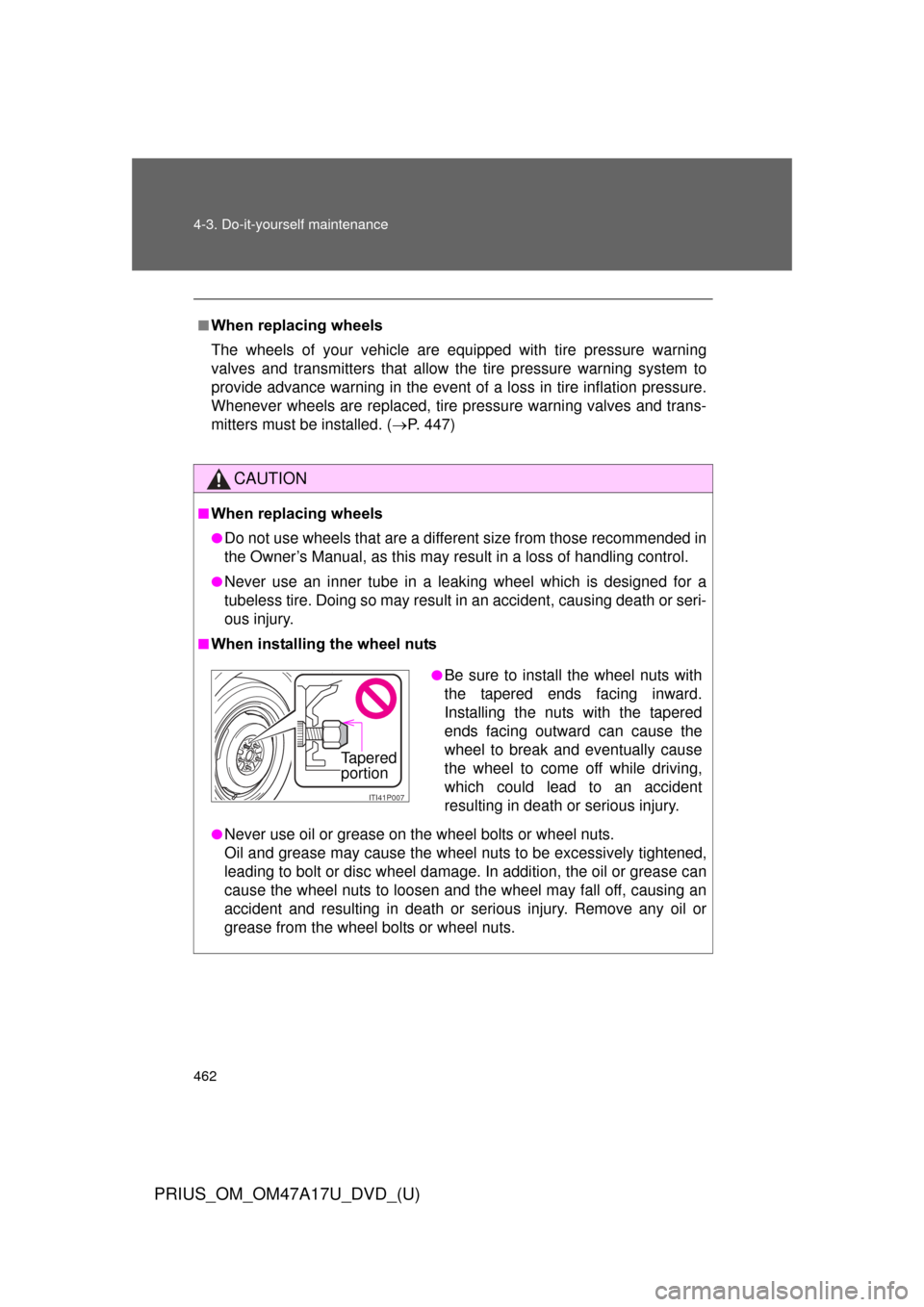Page 459 of 644

459
4-3. Do-it-yourself maintenance
PRIUS_OM_OM47A17U_DVD_(U)
4
Maintenance and care
■Tire inflation pressure check interval
You should check tire inflation pressure every two weeks, or at least
once a month.
Do not forget to check the spare.
■Effects of incorrect tire inflation pressure
Driving with incorrect ti
re inflation pressure ma y result in the following:
●Reduced fuel efficiency
●Reduced driving comfort and tire life
●Reduced safety
●Damage to the drive train
If a tire needs frequent inflating, have it checked by your Toyota dealer.
■Instructions for checking tire inflation pressure
When checking tire inflation pressure, observe the following:
●Check only when the tires are cold.
If your vehicle has been parked for at least 3 hours or has not been
driven for more than 1 mile or 1.5 km, you will get an accurate cold
tire inflation pressure reading.
●Always use a tire pressure gauge.
The appearance of the tire can be mi sleading. In addition, tire infla-
tion pressure that is even just a few pounds off can affect ride quality
and handling.
●Do not reduce tire inflation pressure after driving. It is normal for tire
inflation pressure to be higher after driving.
●Never exceed the vehicle capacity weight.
Passengers and luggage weight should be placed so that the vehicle
is balanced.
Page 460 of 644
460 4-3. Do-it-yourself maintenance
PRIUS_OM_OM47A17U_DVD_(U)
CAUTION
■Proper inflation is critical to save tire performance
Keep your tires properly inflated. Otherwise, the following conditions
may occur and result in an accident causing death or serious injury:
●Excessive wear
●Uneven wear
●Poor handling
●Possibility of blowouts resu lting from overheated tires
●Poor sealing of the tire bead
●Wheel deformation and/or tire separation
●A greater possibility of tire damage from road hazards
NOTICE
■When inspecting and adjusting tire inflation pressure
Be sure to put the tire valve caps back on.
Without the valve caps, dirt or mo isture could get into the valve and
cause air leakage, which could result in an accident. If the caps are lost,
replace them as soon as possible.
Page 462 of 644

462 4-3. Do-it-yourself maintenance
PRIUS_OM_OM47A17U_DVD_(U)
■When replacing wheels
The wheels of your vehicle are equipped with tire pressure warning
valves and transmitters that allow the tire pressure warning system to
provide advance warning in the event of a loss in tire inflation pressure.
Whenever wheels are replaced, tire pressure warning valves and trans-
mitters must be installed. (P. 447)
CAUTION
■When replacing wheels
●Do not use wheels that are a different size from those recommended in
the Owner’s Manual, as this may resu lt in a loss of handling control.
●Never use an inner tube in a leaking wheel which is designed for a
tubeless tire. Doing so may result in an accident, causing death or seri-
ous injury.
■When installing the wheel nuts
●Never use oil or grease on the wheel bolts or wheel nuts.
Oil and grease may cause the wheel nuts to be excessively tightened,
leading to bolt or disc wheel damage. In addition, the oil or grease can
cause the wheel nuts to loosen and the wheel may fall off, causing an
accident and resulting in death or serious injury. Remove any oil or
grease from the wheel bolts or wheel nuts.
●Be sure to install the wheel nuts with
the tapered ends facing inward.
Installing the nuts with the tapered
ends facing outward can cause the
wheel to break and eventually cause
the wheel to come off while driving,
which could lead to an accident
resulting in death or serious injury.
ITI41P007
Ta p e r e d
portion
Page 463 of 644
463
4-3. Do-it-yourself maintenance
PRIUS_OM_OM47A17U_DVD_(U)
4
Maintenance and care
CAUTION
■Use of defective wheels prohibited
Do not use cracked or deformed wheels.
Doing so could cause the tire to leak air during driving, possibly causing
an accident.
NOTICE
■Replacing tire pressure warning valves and transmitters
●Because tire repair or replacement may affect the tire pressure warn-
ing valves and transmitters, make su
re to have tires serviced by your
Toyota dealer or other qualified service shop. In addition, make sure to
purchase your tire pressure warning valves and transmitters at your
Toyota dealer.
●Ensure that only genuine Toyota wheels are used on your vehicle.
Tire pressure warning valves and transmitters may not work properly
with non-genuine wheels.
Page 474 of 644

474 4-3. Do-it-yourself maintenance
PRIUS_OM_OM47A17U_DVD_(U)
FUSEAmpereCircuit
14 STOP 10A Stop lights, high mounted stop-
light, brake system, driver support
system, vehicle proximity notifica-
tion system
15 P FR DOOR 25A Power windows
16 D FR DOOR 25A Power windows
17 DOOR RR 25A Power windows
18 DOOR RL 25A Power windows
19 S/ROOF 30A Moon roof
20 ECU-IG NO.1 10A Electric cooling fans, multiplex
communication system, vehicle
proximity notification system
21 ECU-IG NO.2 10A Driver support system, Pre-Colli-
sion System, LKA system, inside
rear view mirror, garage door
opener, yaw rate & G sensor,
brake system, electric power
steering, navigation system, moon
roof, tire pressure warning system,
seat belt pretensioners, audio sys-
tem, emergency flashers, turn sig-
nal lights, windshield wipers,
headlight cleaner
22 GAUGE 10AHeadlight leveling system, gauges
and meters, emergency flashers,
turn signal lights
23 A/C 10AAir conditioning system, Solar
Ventilation System, Remote Air
Conditioning System
Page 509 of 644
5
When trouble arises
509
5-2. Steps to take in an emergency
PRIUS_OM_OM47A17U_DVD_(U)
Warning lightWarning light/DetailsCorrection
procedure
Tire pressure warning
light
When the light comes
on:
Low tire inflation pres-
sure such as
• Natural causes ( P. 511)
• Flat tire ( P. 537) Adjust the tire
inflation pressure
to the specified
level.
The light will turn
off after a few
minutes. In case
the light does
not turn off even
if the tire infla-
tion pressure is
adjusted, have
the system
checked by your
Toyota dealer.
When the light comes
on after blinking for
1 minute:
Malfunction in the tire
pressure warning sys-
tem ( P. 513) Have the system
checked by your
Toyota dealer.
Master warning light
The warning light comes
on and flashes to indicate
that the master warning
system has detected a
malfunction.
P. 5 1 7
Page 511 of 644

5
When trouble arises
511
5-2. Steps to take in an emergency
PRIUS_OM_OM47A17U_DVD_(U)
■
Electric power steering system warning light (warning buzzer)
When the 12-volt battery charge becomes insufficient or the voltage tempo-
rarily drops, the electric power steering system warning light may come on
and the warning buzzer may sound.
■ If the malfunction indicator lamp comes on while driving
First check the following:
● Is the fuel tank cap loose?
If it is, tighten it securely.
The malfunction indicator lamp will go off after several driving trips.
If the malfunction indicator lamp does not go off even after several trips, con-
tact your Toyota dealer as soon as possible.
■
When the tire pressure warning light comes on
Check the tire inflation pressure and adjust to the appropriate level.
Pushing the tire pressure warning re set switch will not turn off the tire
pressure warning light.
■The tire pressure warning light may come on due to natural causes
The tire pressure warning light may come on due to natural causes such
as natural air leaks and tire inflat ion pressure changes caused by tem-
perature. In this case, adjusting the tire inflation pressure will turn off the
warning light (after a few minutes).
■When a tire is replaced with a spare tire
The compact spare tire is not equipped with a tire pressure warning
valve and transmitter. If a tire goes flat, the tire pressure warning light will
not turn off even though the flat tire has been replaced with the spare
tire. Replace the spare tire with the re paired tire and adjust the tire infla-
tion pressure. The tire pressure wa rning light will go off after a few min-
utes.
Page 512 of 644

512 5-2. Steps to take in an emergency
PRIUS_OM_OM47A17U_DVD_(U)
■If the tire pressure warning system is not functioning
The tire pressure warning system will be disabled in the following condi-
tions:
(When the condition becomes normal, the system will work properly.)
●If tires not equipped with tire pressure warning valves and transmit-
ters are used
●If the ID code on the tire pressure warning valves and transmitters is
not registered in the tire pressure warning computer
●If the tire inflation pressure is 73 psi (500 kPa, 5.1 kgf/cm2 or bar) or
higher
The tire pressure warning system may be disabled in the following condi-
tions:
(When the condition becomes normal, the system will work properly.)
●If electronic devices or facilities using similar radio wave frequencies
are nearby
●If a radio set at a similar frequency is in use in the vehicle
●If a window tint that affects the radio wave signals is installed
●If there is a lot of snow or ice on the vehicle, particularly around the
wheels or wheel housings
●If non-genuine Toyota wheels are used (Even if you use Toyota
wheels, the tire pressu re warning system may not work properly with
some types of tires.)
●If tire chains are used